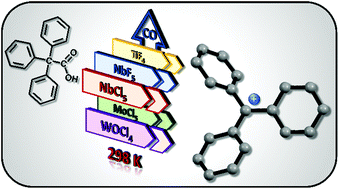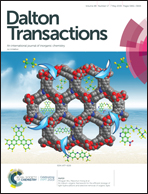Decarbonylation of phenylacetic acids by high valent transition metal halides†
Abstract
Triphenylacetic acid underwent unusual decarbonylation when allowed to react with a series of halides of group 4–6 metals in their highest oxidation state, in dichloromethane at ambient temperature. Thus, the reaction of CPh3COOH with MoCl5, in 1 : 1 molar ratio, afforded the trityl salt [CPh3][MoOCl4], 1, in 79% yield, while the 1 : 2 reaction of CPh3COOH with NbF5 afforded [CPh3][NbF6], 2, in 70% yield, NbOF3 being the metal co-product. CPh3COOH reacted with NbCl5, TiF4 and WOCl4 to give mixtures of compounds, however the cation [CPh3]+ was NMR identified in each case. [CPh3][NbCl6], 3, was isolated from NbCl5 and CPh3COCl, prior to being generated from CPh3COOH and PCl5. The reaction of CPh3COOH with TiCl4 was non-selective, and the salt [CPh3][Ti2Cl8(μ-κ2-O2CCPh3)], 4, was obtained in 18% yield. The decarbonylation reactions of CMePh2COCl and CMe2PhCOCl by means of NbCl5 led to the indanes 5a–b, which were isolated in 79–97% yields after hydrolysis of the mixtures and subsequent alumina filtration of the organic phases. The reactions of CH(Ph)2COOH with NbCl5 and WCl6 afforded NbCl4(OOCCHPh2), 6, and CHPh2COCl, respectively, as the prevalent species. CPh2(CH2CH2Br)COOH did not undergo CO release when allowed to interact with WCl6, instead selective intramolecular condensation to ![[upper bond 1 start]](https://www.rsc.org/images/entities/char_e010.gif) C(Ph)2C(
C(Ph)2C(![[double bond, length as m-dash]](https://www.rsc.org/images/entities/char_e001.gif) O)OCH2C
O)OCH2C![[upper bond 1 end]](https://www.rsc.org/images/entities/char_e011.gif) H2, 7, occurred. MeC
H2, 7, occurred. MeC![[triple bond, length as m-dash]](https://www.rsc.org/images/entities/char_e002.gif) CCOOH underwent hydrochlorination by WCl6 to give MeC(Cl)
CCOOH underwent hydrochlorination by WCl6 to give MeC(Cl)![[double bond, length as m-dash]](https://www.rsc.org/images/entities/char_e001.gif) CHCOOH, 8, in 72% yield. All the products were fully characterized by elemental analysis, IR and multinuclear NMR spectroscopy. In addition, the solid state structures of 1, 2, 4, 7, and 8 were elucidated by X-ray diffraction.
CHCOOH, 8, in 72% yield. All the products were fully characterized by elemental analysis, IR and multinuclear NMR spectroscopy. In addition, the solid state structures of 1, 2, 4, 7, and 8 were elucidated by X-ray diffraction.



 Please wait while we load your content...
Please wait while we load your content...